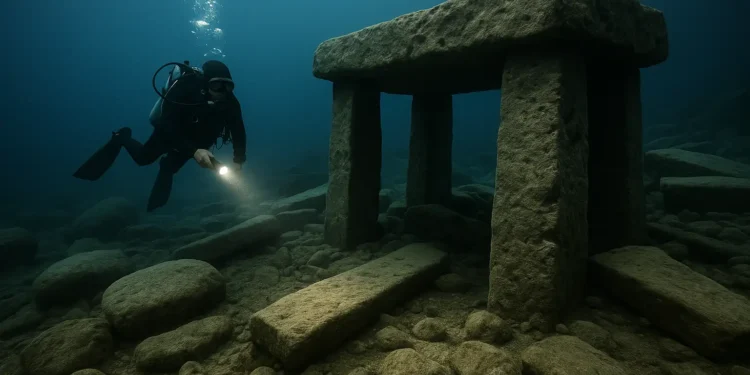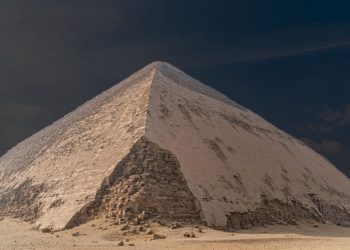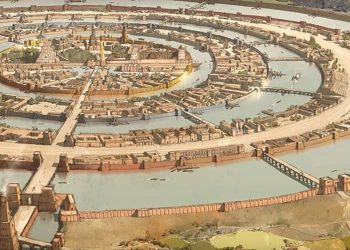Imagine standing on the shores of the modern-day Black Sea about 8,000 years ago. Instead of brackish waves, you would have seen a calm freshwater lake surrounded by fertile plains and forested hills. That landscape changed dramatically around 7,600 years ago. Marine geologists William Ryan and Walter Pitman, after years of sediment analysis and sonar scans, proposed that a catastrophic flood had occurred when rising Mediterranean waters surged through the Bosporus Strait. This event rapidly transformed the Black Sea from a freshwater lake into a vast saltwater basin.
Sediment cores taken from the seabed reveal ancient shorelines more than 100 meters below present sea level, supporting the idea of a sudden inundation. While this event occurred after the last Ice Age, it remains one of the most dramatic post-glacial sea-level changes. It has led some researchers to wonder whether human settlements—perhaps even early civilizations—were lost beneath the rising waters.
Echoes Beneath the Waves
Over the past two decades, researchers have mapped submerged landscapes along the Black Sea’s former shoreline. Using sonar and underwater drones, they’ve documented features that appear to show organized shapes and linear patterns. While some formations resemble terraces or walls, these interpretations remain speculative. No peer-reviewed study has yet confirmed the presence of definitive pre-Holocene architecture beneath the Black Sea.
Still, the surrounding basin was once fertile and habitable. Archaeological evidence from the nearby Anatolian and Balkan regions shows Neolithic communities thriving in the millennia leading up to the flood. It’s plausible that similar groups occupied now-submerged lowlands. If so, their settlements may have been erased swiftly, with little trace left behind—except perhaps in the memories of their descendants.
Göbekli Tepe: A Clue from Stone
Evidence of complex human activity at the end of the Ice Age does exist—above sea level. Göbekli Tepe, located in southeastern Turkey (one of my absolute favorite sites), was constructed around 9600 BCE, shortly after the Younger Dryas cold snap. The site features towering limestone pillars, some up to 10 tons, carved with animals, symbols, and abstract motifs. Its builders used advanced quarrying and organizational skills, even though they had no pottery, no written language, and no domesticated crops.
The sophistication of Göbekli Tepe challenges the traditional view that complex societies only emerged after agriculture. While the people who built it were likely hunter-gatherers, they clearly had the social coordination and symbolic systems often associated with later civilizations. This raises the question: Could Göbekli Tepe represent a surviving cultural lineage—descendants of an earlier, now-lost society forced to adapt after environmental collapse? Or is Göbekli Tepe a civilization on its own? Lost to time? If you believe there is a possibility, read this article I wrote a while back.
Atlantis Reconsidered
References to lost civilizations are not limited to scientific theories. Plato’s tale of Atlantis, often regarded as a philosophical allegory, has inspired generations of researchers to search for real-world parallels. Around the globe, underwater features have stirred debate: the Yonaguni Monument off Japan, structures in the Gulf of Khambhat off India, and the Bimini Road near the Bahamas.
The Bimini Road, in particular, consists of large, flat stones arranged in a roughly linear path just offshore. While many geologists identify it as natural beachrock shaped by erosion and wave action, a few researchers argue the stones show signs of human modification. No definitive tools or artifacts have been found to confirm this, and mainstream science considers the formation natural. However, its ambiguity keeps it in the public eye and reflects a broader curiosity about what the oceans might be hiding.
Younger Dryas and the Cosmic Impact Theory
Some scientists argue that the abrupt climate shift around 12,900 years ago—the Younger Dryas—was caused by a cosmic impact. This theory, known as the Younger Dryas Impact Hypothesis, proposes that a comet or asteroid exploded in the atmosphere over North America or Greenland, triggering wildfires, global cooling, and widespread ecological disruption.
Supporting evidence includes peaks in platinum levels, nanodiamonds, and tiny glass-like spheres found in geological layers from that time. However, the scientific community remains divided. Critics point to the lack of a definitive crater, while proponents argue the explosion may have occurred in the air or on ice, leaving minimal physical trace.
If the hypothesis is correct, such an event could have devastated early societies, particularly those concentrated in vulnerable lowland regions. Any civilization that had emerged by then may have been scattered or reduced to small bands of survivors, their cultural memory passed on through story, symbol, and myth.
Hidden in Oral Tradition
Across the world, traditional stories tell of great floods, fire from the sky, and civilizations destroyed in cataclysm. The Mesopotamian Epic of Gilgamesh recounts a massive deluge. In Hindu texts, Manu survives a divine flood. Native American, Aboriginal Australian, and African oral traditions include tales of fire, shaking earth, and rising seas.
Historians caution against taking myths at face value. Still, the shared elements in these narratives are striking. While independent invention is possible, some scholars suggest these stories may preserve collective memories of real events—filtered through generations and transformed by cultural lenses. If so, they could offer clues to a time when humanity faced disasters so profound that only myth could preserve their meaning.
The Pursuit of Proof
The biggest challenge in confirming a pre-Ice Age civilization is the passage of time itself. Sea levels rose more than 120 meters after the last glacial maximum, submerging vast coastal areas where early populations likely lived. Underwater environments accelerate decay: wood, bone, and textiles degrade rapidly; storms and currents bury or break structures.
Yet technology is closing the gap. Multibeam sonar, underwater LIDAR, submersible drones, and satellite topography have revealed ancient coastlines, submerged forests, and even stone tools off modern coasts. The North Sea’s “Doggerland,” once a land bridge between Britain and Europe, has yielded Mesolithic artifacts and evidence of human habitation. Similar efforts in the Mediterranean, Black Sea, and Indian Ocean may one day reveal even older remains.
Rethinking Human History
The possibility of advanced human cultures existing before the Ice Age challenges a long-standing assumption: that complexity only began with farming. Sites like Göbekli Tepe already stretch that assumption. If further evidence of submerged or forgotten civilizations emerges, it would force a fundamental rethinking of our timeline.
We would need to ask: how many times have humans risen, innovated, and then fallen—only to rise again? History, it seems, may be cyclical rather than linear. Climate events, impacts, and floods may have wiped out not just species, but whole societies—some of which left only the faintest traces behind.
Looking Forward by Looking Back
At present, no conclusive proof exists for a pre-Ice Age civilization. But the growing body of anomalies, underwater features, and ancient sites like Göbekli Tepe ensures that the question won’t go away. It remains one of archaeology’s most provocative frontiers. I see, for example, Göbekli Tepe as the ultimate proof of a civilization BEFORE civilization. I see it as a period in human history that is not included in history books. I see this site, and all of the sites around it, as a smoking gun that Earth did have advanced civilizations in the past, but mainstream experts are perhaps just too lazy or afraid to admit it.
I think that the drive to uncover these lost histories is not merely academic, it’s human. Every excavation, every dive, every sonar ping reflects our desire to understand where we came from. In the oceans’ depths and in the stories we tell, hints of a forgotten past continue to whisper. Whether those whispers grow into evidence remains to be seen. I see Göbekli Tepe as a history breaker. Isn’t it time for our history books to change?











